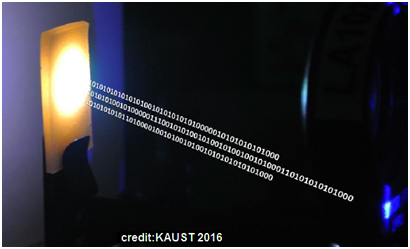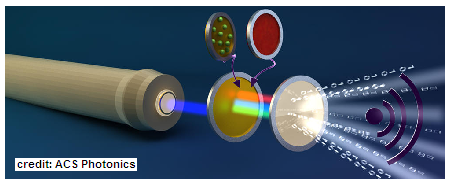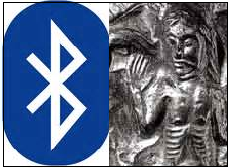oom lighting may now double as a high capacity WIFI transmitter, says S.Ananthanarayanan.

Light waves have long been used to carry information. Light itself was used at first, by the lighthouse, in signal flares or the Morse flasher, and then, invisible light was used, as radio waves. While telephony got started with electrical signals, speech and data are now carried by infra-red waves that run though glass fibres and the final link to the user has been with radio waves, from the WIFI or by a Bluetooth connection.
These later methods, which use radio waves, however, may not be good enough for coming demands for transferring images and large data. This is both because of limitations on the amount of data that can be passed on with the wavelengths used and also because radio waves are used for communications and only a limited range is available for computers and related devices. This apart, there are advantages if white light that is used for data transfer comes from the same sources as general room lighting.
Ibrahim Dursun, Chao Shen, Manas R. Parida, Jun Pan, Smritakshi P. Sarmah, Davide Priante, Noktan Alyami, Jiakai Liu, Makhsud I. Saidaminov, Mohd S. Alias, hmed L. Abdelhady, Tien Khee Ng, Omar F. Mohammed, Boon S. Ooi, and Osman M. Bakr, at the King Abdullah University of Science and Technology (KAUST), at Thuwal, Kingdom of Saudi Arabia, report in the American Chemical Society journal,ACS Photonics, a development that overcomes limitations of existing lighting devices for use in data transfer.
The current technology of lighting, which can be integrated with electronics, is the Light Emitting Diode, the LED. In the LED, semiconductors, the material of transistors, have free electrons and also spaces called ‘holes’, which ‘lack an electron’ and which are kept apart. But when a voltage is applied, electrons rush to fall into holes and in the process they give off a flash of light. As LEDs can be switched on an off at a very fast rate, the flashes can be used transmit large data in binary format. As the high speed switching cannot be made out by the human eye, the LED can be used for illumination at the same time. The trouble, however, is that LED light is of a specific colour and the illumination is not by white light.
A solution, for general lighting use, was to use a trio of LEDs, emitting in the primary colours. This led to the field of solid state lighting (SSL) and also allows the LED to be used in displays, like full colour TV screens. For use for data transfer, where the light needs to be switched on an off, however, it is necessary that the light come from the same source, and not from three different LEDs. This, or Visible Light Communication (VLC), has been attained with the most recently developed blue light LED, or laser diodes, which are used along with materials that convert blue light into green and red, or yellow, to shine together as white light. The problem, however, has been that these colour-converting materials, which are called phosphors, are not fast enough for complementary colours to change as soon as the blue LED or the laser, is switched on or off. The time taken, the KAUST paper says, is of the order of microseconds, or millionths of a second, and the switching of the white light, for data transfer in existing VLC, cannot be faster than three to twelve million times a second. Alternate color converters which have been developed do allow speeds of forty to two hundred million cycles a second, but this still falls short of what is needed, the KAUST authors say.
Perovskites
The KAUST authors hence studied the properties of a class of materials calledperovskites, a mineral variety with a particular generic structure, of an atom which has three outer shell electrons, one which has four and one which has two. These materials have most interesting electrical and optical properties and have become important components of solar cells and may take the place of silicon in some applications. The make up of these materials can be arranged so that they have emission of light at specific frequencies, the authors say. They are also low cost and easily worked with at reasonably low temperatures, they say. Nano crystals of one kind of Perovskite, which contains cesium, lead and bromine atoms, they say, have a very high luminescent yield and the flash has a very short lifetime. These qualities have made the material useful in displays and for creating sources of white light.

The researchers hence studied the possibility of this material being used in VLC applications, side by side with being a white light source for SSL devices. They find, the papers says, that the material has excellent colour rendering capacity and also reacts very fast, in a time frame of 7 billionths of a second, which makes for colour converting frequency of 491 million cycles a second. This is forty times higher than the frequency of some 12.4 million cycles a second which is currently available.

The amount of data that can be carried over a channel that has a given range of frequency is dependent on the manner of coding that is used to represent the data, like binary, which is ‘on-off’ or ‘phase shifting’, which can double the data rate. The trials conducted with the lead and bromine containing perovskites showed that the data rate could go as high as 2 gigabits, or two billion units of information, which amounts to 125 million characters of text, every second.
Apart from this significantly higher data carrying capacity, the emission is bright, white light, which can be used for home or office lighting. The white light from the switched LEDs, unlike light from incandescent lamps is not continuous nor, like the fluorescent lamp, with a steady flicker at the frequency of alternating power supply. Instead, the light has a flicker in nanoseconds, and the pattern of flicker carries exact information of data being transmitted. Optical sensors within the area that is lighted can hence pick up the data. With capacity of 2 gigabits a second, different sets of data, meant for different devices, can be sent out at the same time, a versatility which a WIFI transmitter or a single Bluetooth device do not have.
Bluetooth
Bluetooth is a convention of data transfer frequency and format which is designed for different classes of devices to communicate at the same time. The characteristic is that a specific range of frequencies is used and the manner, or format of data transmission, how the ‘0’s and ‘1’s would be spaced and how errors would be detected, is specified.
When Bluetooth devices agree to communicate, they exchange information of a random way of switching from one frequency to another, out of the 79 slots into which the range has been divided, and they change frequency 1,600 times a second. The signal from a device can hence be read only by another device which ‘hops frequencies’ at the same rate as the first device, and many pairs of devices can be in action at the same time
The technology thus represents a specification that manufacturers of different devices could agree upon, to allow a variety of devices to work together, without the need for the exercise of ‘configuring’. The standard was first agreed upon by Denmark, Norway, Sweden and Finland and was named after
Harald Bluetooth, a 10th century ruler of Denmark, who had first imagined a unified European state. 
------------------------------------------------------------------------------------------